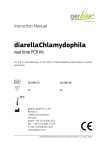Download Print Version - A4 - Scleroderma Education Project
Transcript
Guide for New and Future Patients About this Guide This Guide for New and Future Patients™ is a companion document to the Scleroderma FAQTM, also available through the Scleroderma Education Project website: www.SclerodermaInfo.org. Think of the main Scleroderma FAQ as the 50-page User Manual that came with your shiny new 65-inch ultra-high definition TV. This Guide is the equivalent of the Getting Started Guide that also came with the TV. While this Guide includes some basic information extracted from the Scleroderma FAQ, it has a very different focus. In addition to giving a basic overview of scleroderma, it is designed to help patients get diagnosed as quickly and accurately as possible. It helps you to be better prepared for your doctor visits and also includes information about tests and procedures that are commonly ordered for patients with scleroderma. After a brief overview of how scleroderma is treated, it also includes some information that should help your family members better understand what you, as a scleroderma patient, are going through. Here is what is included in this Guide: • Scleroderma Overview –This initial section gives a general description of the scleroderma family of diseases and discusses the affected population, possible causes, and typical symptoms. • Scleroderma Diagnosis – Diagnosing someone with scleroderma can be a lengthy and challenging task, even for a specialist with a lot of training in autoimmune diseases. However, most of the time the initial stages of diagnosing scleroderma are usually done by a primary care practitioner (PCP), such as an internist, Family Medicine doctor, or nurse practitioner with little or no experience with a rare disease like scleroderma. This section of the Guide is designed to help you and your PCP avoid common major problems that can result from ordering the wrong diagnostic tests. • Preparing for Your Doctor Visit –This section of the Guide helps you be prepared to make the best use of your time when visiting your primary doctor or specialists. It includes some suggested questions and other information that will help you to make sure that these visits are as productive as possible. • Baseline and Routine Testing –This section describes many of the common tests that may be ordered to help during the diagnostic stages or later, if you are eventually diagnosed with some type of scleroderma. • Scleroderma Treatment Overview –This section of the Guide gives an overview of scleroderma treatment approaches, including some treatment approaches that are considered experimental or alternative. • A Note for Family Members and Friends – Scleroderma affects everyone in a family and a relationship, not just the patient. This section of the Guide can help family members and friends better understand what the scleroderma patient is going through and how they can best be supportive. 1 You may wonder about the part of the title of this document: “and Future Patients.” If you are not yet diagnosed with scleroderma, why are you looking for information about this rare disease? The reality is that diagnosing scleroderma, as will be discussed later in this document, can sometimes be very tricky. Most people start their diagnostic journey with a primary care provider (PCP), typically a family medicine or internal medicine doctor, or increasingly these days a primary care nurse practitioner (NP). Many PCPs will see at most one or two patients with scleroderma in their entire career. Ultimately, patients with scleroderma need to be under the care of a rheumatologist – someone who focuses on autoimmune diseases like rheumatoid arthritis, lupus, or scleroderma. But even then, many rheumatologists see very few scleroderma patients, and only a very small number of rheumatologists specialize in this disease, since it is much less common than other autoimmune conditions that they treat. Early in the diagnostic process, a skilled PCP may realize that something is going on with a patient that might be an autoimmune disease and order initial diagnostic tests to try to narrow that possibility down . (There can be major problems with the wrong tests being ordered – more on this later.) The results of the initial testing may be enough to suggest that the patient is dealing with an autoimmune disease, but without further testing, it is not clear whether the patient might have lupus, scleroderma, or Mixed Connective Tissue Disease (MCTD). At this point, if you are that patient, you probably searched the Internet for information about all of these diseases and may have located this website during your search. So that is one way you might get here even without a scleroderma diagnosis. However, in this modern age it is very common for patients to realize at some point that they have symptoms that are not right and start Googling those for more information, e.g., Raynaud’s, heartburn, puffy fingers, etc. If they are skilled at doing intensive Google searches, they might find sites that steer them to decide (usually incorrectly) that they have late stage diffuse scleroderma and have only a few months to live! Also, since they now can’t breathe (because they are in a panic) and their heart is pounding, they have even more symptoms than they thought, confirming the seriousness of their “Google Diagnosis.” One objective of this website and this document is to provide clear and accurate information to assuage any panic arising from reviewing multiple sources, some scary, and give patients correct guidelines to help them move forward with their providers. The third category of patients who are likely to be reading this document are those that have gone through the (sometimes long) process of actually getting a diagnosis and want to learn more about their disease, so they can better understand what they are dealing with and how to share this information with their family and friends. This new Guide is a good place to start, but when you are looking for more detailed information about scleroderma diagnosis and treatments, you will instead want to refer to the main Scleroderma FAQ. Scleroderma Overview Scleroderma (literally "hard skin") is an umbrella term for a family of rare diseases with the common factor being abnormal thickening (fibrosis) of the skin. However, not everyone with scleroderma develops skin changes. With some variants of the disease, skin changes usually occur early in the disease process and can develop very rapidly. With other forms of scleroderma, skin changes may not occur for many years after the development of other symptoms and in rare cases may never be a significant symptom of the disease. There are two main groupings of the scleroderma family of diseases: Localized and Systemic, as shown in the diagram below: 2 Overview of Scleroderma Family of Diseases Generally speaking, the localized forms of scleroderma are limited to different kinds of skin changes and do not have internal organ involvement. In contrast, the systemic forms of scleroderma are complex autoimmune diseases that affect organs throughout the body in addition to skin changes. The focus of both the Scleroderma FAQ and this Guide is on the systemic forms of scleroderma, although basic information is included in the FAQ on the localized forms of scleroderma. Within the systemic forms of scleroderma, there are three major categories of the disease: diffuse, limited and overlap syndromes. The more rapidly progressing forms of systemic scleroderma are in a category called diffuse scleroderma. In research literature, this is referred to as diffuse cutaneous systemic sclerosis and is commonly abbreviated as dcSSc. This form of systemic scleroderma is typically characterized by rapid development of skin thickening, beginning with the hands and face and extending to the arms and trunk. People with diffuse scleroderma are at greater risk for developing internal organ involvement early in the disease process. The specific internal organ systems that are affected depends to some degree on which specific type of diffuse scleroderma the patient has, as often indicated by the patient’s antibody profile. The second major category of systemic scleroderma is called limited scleroderma. The word “limited” refers to the fact that the skin involvement in this form of systemic scleroderma is usually limited to the lower arms and legs and sometimes the face. There is still significant internal organ involvement with limited scleroderma, but it generally develops more slowly than with the diffuse form. In research literature, this is referred to as limited cutaneous systemic sclerosis and is commonly abbreviated as lcSSc. It is worth noting that this form of scleroderma used to be referred to as CREST Syndrome, and you will still find many articles that use the older term. While limited scleroderma progresses more slowly and has a better overall prognosis than diffuse scleroderma, different variants of limited scleroderma (based on antibody profile) have different complication risks over the long term. The third category of systemic scleroderma is a diverse group that is generally referred to as scleroderma overlap syndromes. With overlap syndromes, while patients have clear scleroderma specific symptoms, they also have symptoms that overlap with other autoimmune diseases including lupus and myositis (muscle inflammation). An example is Mixed Connective Tissue Disorder, which includes symptoms that are common in scleroderma, lupus, and myositis. The specific antibody determines the nature of the overlap syndrome. Affected Population Recent studies estimate that in the US the incidence of new cases is about 20 per million adults (about 4800 new cases per year based on current US population estimates) and that the current prevalence is about 240 cases per million adults (about 60,000 total active 3 cases). The American College of Rheumatology estimates that the number may be as high as 100,000 people in the US. A number of international studies suggest that scleroderma occurs much more frequently in the United States than elsewhere. These regional differences may be a consequence of differential genetic susceptibility to scleroderma, different exposure to possible environmental triggers, different diagnostic criteria, or a combination of these factors. Scleroderma may occur at any age, but the symptoms most frequently begin in mid-life (2545). The diffuse and limited forms of scleroderma are very rare in children. The disease is about 4 times more common in women than men. There seems to be a relatively weak genetic link with scleroderma. Close order relatives of an affected individual are more likely to have some type of autoimmune condition but this is more likely to be a different disease, such as rheumatoid arthritis, Hashimoto’s (autoimmune hypothyroidism), Graves (autoimmune hyperthyroidism), or lupus. Also, close order relatives of affected patients may have elevated anti-nuclear antibody (ANA) levels as compared to the normal population, but without any symptoms of any autoimmune disease. Causes The exact cause of scleroderma is unknown. There are a number of environmental factors that appear to be related to scleroderma or scleroderma-like illnesses, including exposure to silica dust, vinyl chloride, epoxy resins, and other organic solvents. Several studies have shown some evidence of geographic clustering, which is also consistent with possible environmental risk factors. Scleroderma is best thought of as a disease with two components: genetic susceptibility and a trigger event, for example, exposure to silica dust or organic solvents. There is some research support for the idea that a subset of scleroderma patients may have systemic infections as a possible trigger for their scleroderma. While there have not been any studies directly linking Lyme disease to scleroderma, there is some research that suggests that Lyme disease may be a possible trigger for scleroderma in susceptible patients. Symptoms One important thing to realize with scleroderma is that while there is some commonality of symptoms for different types of scleroderma, there is a tremendous variability in terms of which symptoms ultimately will occur and in what order. Scleroderma often begins with Raynaud's phenomenon - the fingers and sometimes the toes lose circulation and turn white upon exposure to cold. Raynaud's phenomenon usually (but not always) precedes skin changes by several months with diffuse scleroderma and often precedes skin changes by several years with limited scleroderma. Other early symptoms may be painful joints, morning stiffness, red swollen hands, fatigue, and/or weight loss. It is important to note, however, that Raynaud’s phenomenon without any underlying disease is not uncommon in the general population, especially among young women. This form of Raynaud’s is called "primary Raynaud’s.". A key distinguishing characteristic is that with primary Raynaud’s, the anti-nuclear antibody (ANA) will normally be negative, while with Raynaud’s which accompanies scleroderma or other auto-immune disorders (secondary Raynaud’s), ANA is usually positive. The vast majority of young women with Raynaud’s symptoms that appear in their teenage years never develop a positive ANA or any systemic damage or skin changes. However, in a small percentage of this population, the early appearance of Raynaud’s symptoms will be followed, sometimes years later, by their ANA becoming positive and additional scleroderma symptoms developing over time. 4 The first specific clinical symptom to suggest a diagnosis of scleroderma is skin thickening that begins as swelling or "puffiness" of the fingers and hands. The puffiness is usually worse in the morning and reduces later in the day, especially in early stages of the disease. Later the skin becomes hard, shiny, and leathery. With diffuse scleroderma, these areas of hardness are widespread and typically appear on both sides of the body. In the more limited form, skin thickening is often restricted to the hands, feet, and face. Eventually, tissue loss occurs and the skin becomes more highly colored. People with limited scleroderma usually have Raynaud’s symptoms for years (often 5 to 10 years) before other signs of scleroderma are noted. However, even the limited form can, in rare cases, present with internal organ involvement without being preceded by Raynaud’s symptoms. Patients with limited scleroderma are less likely to develop severe lung, heart, or kidney involvement than patients with diffuse disease, although all of these complications can occur late in the disease process. Many patients with limited scleroderma eventually develop a cluster of symptoms that are listed using the acronym CREST – the old name for limited scleroderma. CREST is an acronym derived from the syndrome’s five most prominent symptoms: • C - calcinosis, painful calcium deposits in the skin. It presents as small, localized, hard masses on fingers, forearms, or other pressure points. • R - Raynaud's phenomenon. Raynaud's phenomenon is characterized by the intermittent loss of blood to various parts of the body - particularly the fingers, toes, nose, and/or ears after exposure to cold and causes tingling sensations, numbness, and/or pain. This can result in ulceration and necrosis of the fingertips and, in some severe cases, lead to amputation of the affected digits. • E - esophageal dysfunction, reflux (heartburn), difficulty swallowing caused by internal scarring. If the heartburn symptoms are not well controlled, the repeated acid exposure can eventually lead to a condition known as Barrett’s esophagus, a precancerous condition. The esophagus may eventually have areas that are narrowed so that swallowing may become difficult. The small intestine may also lose the ability to push food through to the large intestine leading to malabsorption and increased bacterial growth in the small intestine. • S - sclerodactyly, thickening and tightening of the skin on the fingers and toes. • T - telangiectasia, red spots on the hands, palms, forearms, face and lips. Depending on the particular antibody profile for patients diagnosed with limited scleroderma, they can be at increased risk of developing kidney failure, lung fibrosis, or pulmonary artery hypertension, but these complications usually occur at a much later date than with diffuse scleroderma. Severe fatigue and muscle pain are also very common symptoms. With diffuse scleroderma, there is usually a short interval (weeks or months) between the development of Raynaud’s and significant additional symptoms, and, in some cases, Raynaud’s will not be the first symptom. Relatively rapid skin changes often occur in the first few months of the disease and continue to progress over the next 2 to 3 years. This is often followed by a partial remission of the skin changes, and the skin either thins or sometimes returns toward normal thickness. The severe fibrosis of the skin, especially in the fingers and hands, can cause significant disability. Diffuse scleroderma can also include a wide range of potential complications, including painful inflammation of the muscles, severe fatigue, swelling of the fingers and/or hands, gastrointestinal problems, lung fibrosis, pulmonary artery hypertension, progressive kidney failure, and cardiovascular problems. Internal organ involvement often occurs early in diffuse scleroderma and can be the initial presenting symptom. 5 Detailed information on scleroderma symptoms can be found in the Scleroderma FAQ. Scleroderma Diagnosis Getting a correct diagnosis when you do in fact have some form of scleroderma can sometimes be a lengthy, frustrating process that can literally take years! This section of the Guide for New and Future Patients explains why this is often the case and provides information for patients (and their physicians) that can often help to make diagnosis a much quicker and easier process. Let’s look at an example of what happens in the real world: A 42-year old woman has been having Raynaud’s symptoms for a number of months but didn’t think much about it in the past. After all, she lives in Minnesota, and the winters are tough. However, lately she has been having more heartburn than usual. Also, during the past couple of weeks she has noticed that her hands are swollen, especially in the morning. She goes to the Internet to search for these symptoms. If she is any good at Google searches, within two minutes she has looked at multiple websites and may diagnose herself with late stage diffuse scleroderma with less than a year to live. She also suddenly notices that she is having a hard time breathing (in her panic), confirming that her lungs are already damaged. She can also feel her heart pounding so yet another late stage symptom is revealed! Panicked, she calls her PCP - a very nice (and competent) family medicine doctor she has seen for years. She finally gets to see her doctor a few days later. The doctor listens to her story and says “It’s probably nothing. A lot of people get more heartburn as they get older and everyone’s fingers are more swollen in the morning. Also, Raynaud’s is not that uncommon, especially with women. I wouldn’t worry about it but we can run an anti-nuclear antibody (ANA) test just to make sure it’s nothing more serious. If you have an autoimmune disease, your ANA test will almost always be positive.” The doctor orders an ANA test with an automatic antibody profile panel, if it turns out to be positive. A few days later, the doctor receives the test results - the ANA is negative. She calls her patient and says, “Everything is fine - don’t worry about it. Take some over-the-counter Prilosec® for the heartburn and call me back in a few months if things don’t get better.” Unfortunately, if the ANA test was run using a very common method called Multiplex testing, recent research indicates that there is up to a 43% chance (depending on the particular Multiplex diagnostic system) that the negative ANA is incorrect (a false negative) for patients with scleroderma! Diagnosis – Step 1: ANA Testing (This next discussion is a bit technical but VERY important, so hang in there…). For many years, ANA testing was done using a method called indirect immunofluorescence (commonly abbreviated as IFA or IIF). This has very high reliability and is the best way to test for the presence of anti-nuclear antibodies. However, it is a complex and timeconsuming test that depends on highly trained laboratory personnel. Recently, many commercial laboratories and some larger hospital laboratories have switched their routine ANA and follow-up specific antibody testing to solid phase immunoassays (ELISA or EIA) or a related technique known as a Multiplex platform. These new techniques are less expensive than IFA. However, these new methods of testing can only detect a limited subset of the specific antibodies that are targeted by the tests (typically 8-13) in contrast to IFA that can detect up to 150 different possible antibodies. As a result, these alternate 6 testing methods are more likely to miss relevant autoantibodies yielding a false negative ANA result, as indicated above. This can have a major impact on scleroderma diagnosis. If the results of an initial ANA screening come back negative to the doctor who ordered the ANA test without knowing this data, this can be the start of (in some cases) years of diagnostic limbo for patients. By the time they are finally retested for ANA by the more comprehensive IFA method, their symptoms will have progressed and may be more difficult to treat. Ironically, had the same ANA plus reflex antibody panel been ordered 15 years ago, the initial ANA test would have been done by IFA, yielding a significantly more accurate result. This raises a serious question as to whether or not modern scleroderma diagnosis is being compromised by using these new, less expensive, testing methods. Unfortunately, almost no primary care physicians (and some rheumatologists as well) are aware of these methodological problems with ANA testing, especially about the potential for incorrect negative results. The American College of Rheumatology in a 2011 Position Paper discusses these problems and recommends that testing by IFA “should remain the gold standard for ANA testing.” While it is true that ELISA and Multiplex ANA testing usually is consistent with IFA ANA testing, if an initial ANA result done by ELISA or Multiplex testing is negative, it is very important that the test be re-run by IFA to confirm the negative results. However, between 2% and 10% of patients (depending on the study) with systemic scleroderma symptoms are ANA negative, even when done by IFA. In some cases, this negative result is false. For example, there are several different ways that ANA by IFA testing is done, for example using human cells or rodent cells to perform the test. Generally, ANA testing by IFA is done using human cells in the US, but if IFA testing is instead done with other types of cells, and the patient has one of the common scleroderma antibody types (anti-centromere or ACA), there is a significant chance that this antibody will not be detected, and the overall ANA result will falsely be reported as negative. In most cases, the ANA does change to positive over time. When this occurs, it makes diagnosis very tricky in many cases. This is discussed more below. It is worth noting that the ANA level is generally stable over time, and there is no evidence that the actual tested ANA level is correlated with disease severity. So what does this mean for someone who is starting the process of potentially being diagnosed with scleroderma? Having just read this information above about ANA testing, you now may well know more about this very narrow topic than almost all primary care docs (and possibly some rheumatologists who don’t specialize in this disease and may not have learned about this research). Educating your doctor can be a very tricky thing to do, but in this case, it is very important to make sure that s/he knows about ANA testing methodology and can thus order the correct type of ANA test. How to approach this potentially difficult interaction with your physician is discussed a bit later in this document. Diagnosis – Step 2: Specific Antibody Testing Actually, in spite of the discussion above, it is perfectly fine for your physician to initially order an ANA test with additional antibody testing, as long as s/he is aware of what method is being used to do the ANA test. The reality is that most of the time, ANA testing done with any of the three methods will end up with the same result. It is common practice at most testing laboratories that if an ANA done by ELISA or Multiplex ends up with a positive result, the standard procedure is to re-run it by IFA to confirm the positive result, and also get the ANA titer (a measure of antibody activity) and then run a disease-specific antibody panel (discussed below). The problem is that the ANA by IFA is not done to 7 confirm a negative result, and this can significantly delay diagnosis if the negative result is a false one. Once a potential scleroderma patient shows a positive ANA, the next step in diagnosis is to test for specific antibodies that can be used to help determine which form of systemic scleroderma the patient has or may develop in the future. Note that often when a patient first comes in with just a few symptoms, a skilled primary care practitioner may pick up some red flags that suggest an autoimmune disease as one possible explanation for the patient’s symptoms. The main symptom (when present) that should suggest to the PCP that there is a possibility of an underlying autoimmune disease is late-onset Raynaud’s. If a female patient, in particular, develops Raynaud’s in her teens or early 20s, then usually this is Primary Raynaud’s, meaning there is probably no underlying disease triggering the symptom, and it will typically just be an annoyance to the patient. In a small number of cases, an underlying autoimmune disorder does eventually develop, but if the primary care practitioner sees a patient that first develops Raynaud’s after age 30, and there is no other direct explanation, e.g., medication side effect, construction worker with vibration damage, certain circulatory problems, then this should automatically trigger at least ANA testing as part of the diagnostic workup. Once it is determined that the patient has a positive ANA result, then the next step in diagnosis is running an appropriate antibody panel to try to figure out what may be going on. This may not actually be a separate step since most physicians will order an ANA test with a reflex antibody panel, but if the ANA is run separately first (by the IFA method), then the physician will order the panel separately after getting the ANA results. This follow-on panel will be specific to that likely disease. For example, if the patient presents with the symptoms listed in the earlier example (Raynaud’s, heartburn, puffy fingers), the physician may realize that scleroderma is the likely diagnosis and order a scleroderma specific panel. However, in many cases, the symptoms are ambiguous enough so that the panel will include the most common antibodies that could be present in a variety of different autoimmune conditions, including lupus and Mixed Connective Tissue Disorder (MCTD), as well as scleroderma. Since the focus of the Scleroderma FAQ and this Guide is on systemic scleroderma, I am not including information and antibodies specific to other autoimmune disorders. The majority of systemic scleroderma patients will test positive for one of three scleroderma related antibodies: anti-Scl-70 (Topoisomerase I) antibodies, anti-centromere (ACA) antibodies, or anti-RNA polymerase III antibodies. The anti-Scl-70 antibody is highly specific for one of the diffuse forms of systemic scleroderma, and the anticentromere antibody is highly correlated with a limited scleroderma variant. Historically, only the anti-Scl-70 and the anti-centromere antibodies were strongly associated with the two general categories of systemic scleroderma: diffuse and limited. The anti-RNA polymerase III antibody is now recognized as a third major scleroderma-related antibody. Patients with anti-RNA polymerase III antibodies are considered to be in the diffuse category, but the specific symptom profile is different from the typical symptoms shown by patients with anti-Scl-70 antibodies. In addition to these three main antibodies, a number of other antibodies have been associated with different subtypes of systemic scleroderma, although these other antibodies are detected much less frequently than the three main antibody types listed above and commercial testing for some of these antibodies is not currently widely available. The Scleroderma FAQ has detailed information about these three main antibodies as well as a number of other scleroderma related antibodies that are less common (see the Antibody section of the Scleroderma FAQ for more information). 8 Diagnosis – Step 3: Additional Clinical Testing When you visit your physician to try to understand what is going on, your specific symptoms will also help the physician decide what additional testing needs to be done. Even if s/he isn’t sure what might be a diagnosis yet, in addition to starting ANA and specific antibody testing, your physician will often decide to run additional tests even before you get initial lab results. For example, if you come in to your office visit indicating that you are having shortness of breath or difficulty exercising, s/he may order additional tests, such as a pulmonary function test (PFT), or a Doppler echocardiogram, or a CAT scan, to try to figure out what is happening with your lungs. If you indicate that you are having a lot of heartburn or difficulty swallowing, s/he may refer you to a GI doctor for an upper endoscopy or esophageal manometry exam. S/he may also want to make sure that your kidneys are functioning OK and order lab tests that are designed to look at potential kidney problems. All of these potential tests are described in more detail in the Scleroderma FAQ. However, even if you are having none of these symptoms, once your physician gets enough information back from lab test results combined with your initial symptoms, it is possible that s/he may order many of these same tests in any case since in early stages of scleroderma, you may have subtle changes going on internally that are not yet causing symptoms but can be more easily treated if detected early. Recommended / standard testing for patients recently diagnosed with scleroderma is discussed later in this Guide. Diagnosis – Step 4: Putting It All Together So now that your physician has run a series of lab tests, looked at your clinical symptoms, and done additional testing that s/he feels is needed, you should be able to get a definitive diagnosis – right? Unfortunately, in many cases, it is not that easy. Let’s look at the diagnostic criteria for scleroderma to start. Up until 2013, the diagnostic criteria for scleroderma were based on a standard that was adopted back in 1980. In 2013, the American College of Rheumatology and the corresponding European organization published a new set of research-based standards for formally diagnosing scleroderma. These new standards take into consideration a number of symptoms that are strongly associated with scleroderma, for example, degree of skin thickening (if any), Raynaud’s, nailbed capillary enlargement, the presence of any of the three main scleroderma-related antibodies mentioned above, etc. This definitely will help clinicians diagnose more patients with scleroderma, but these new standards were actually developed to make it easier to do scleroderma research, not to help clinicians diagnose patients with scleroderma. The research article that describes these new standards does mention this, but unless you actually read the detailed article (which almost no clinicians will do), they will not realize this. Because of the way the research was done when developing these new standards, many symptoms that are strongly associated with scleroderma are not included, for example, GI symptoms such as heartburn or difficulty swallowing, or even major symptoms such as scleroderma renal crisis (SRC). The new diagnostic standard includes a simple-to-use point system where numeric point values are assigned to various clinical symptoms. If the total number of points is 9 or greater, then the patient meets the formal (research) criteria for scleroderma. This is explained in detail in the Scleroderma FAQ. However, even then, it doesn’t distinguish among the scleroderma subtypes (e.g., limited or diffuse). Also, if the clinician ignores additional symptoms, s/he may decide (incorrectly) that the patient doesn’t have scleroderma because their point total is less than 9. Another diagnostic challenge is that lab test results are sometimes not at all clear, or the symptom profile doesn’t quite fit the “normal” pattern for scleroderma (or another autoimmune disease). It turns out that a small number of patients truly have symptoms of more than one autoimmune disease, e.g., some form of scleroderma combined with some 9 variant of lupus. These “crossover” situations are very difficult to figure out and different clinicians, even specialists, may interpret the patient’s symptoms differently. The good news is that this is not very common. The bad news is that if you are one of the patients with ambiguous test results and symptoms, you may have a hard time getting an accurate diagnosis. However, in most cases the treatments used are based more on the symptoms than on the formal diagnosis, so ultimately it may not make that much difference in what treatments are suggested by the patient’s symptoms. Unfortunately, in the US in particular, health insurance companies often decide what treatments they are willing to cover based on the formal diagnosis. Preparing for Your Doctor Visit Even if this is not your first visit to your doctor, a lot of the information in this section should be helpful on future visits. General note: Scleroderma and other autoimmune diseases are chronic conditions, which means that you and your provider(s) will be in a working relationship for a long time. Because of this, it is very important that you feel that your provider is taking the time to listen to your questions and concerns and also is willing to hear your own ideas about how you would like to proceed with your health care decisions. The fact that you are reading this document (and the much more comprehensive Scleroderma FAQ) means that you have decided that you want to understand your (potential) disease and also to be involved in care decisions. If you feel that your doctor is not willing to listen to you, then you may want to consider switching to a different doctor. Things to Bring to Your Doctor Visit • A spouse, significant other, family member, or friend in good working order. What do I mean by “good working order”? Basically, you need a level-headed advocate with you since you may be emotionally upset or shut down when you are first trying to deal with the possibility that you may be facing a serious disease. Your reaction is entirely normal and even healthy, since it shows that you are not in denial that something serious might be wrong. The person that accompanies you on your doctor visits should be able to listen carefully to what the doctor is saying and take notes that you can review later. S/he also needs to know the questions that you wanted to ask your doctor to make sure that the questions are addressed. It is very common for normally assertive, talkative people to clam up completely during a doctor visit, so your advocate will be there to make sure that you get all the answers that you need. • A list of things to ask about. If this is your initial visit to your provider to discuss the symptoms that are concerning you, or if this is the first visit since your provider indicated that you might have scleroderma (among other possibilities), you will have many questions. In addition to the questions that you already have on your personal list, here are a few additional topics to discuss with your doctor that you might not have thought about: o Make sure every doctor has access to your medical records and lab test results. As a lot of scleroderma patients can attest to, the scleroderma diagnostic journey can be a lengthy one involving many different doctors. For example, while most people start with a visit to a primary care provider, the diagnostic process frequently involves trips to specialists, for example, neurologists, gastroenterologists, rheumatologists, and others. If you are fortunate enough to treat at a large medical center or belong to an HMO, it is increasingly likely that all of your providers will have easy access to a centralized electronic medical record (EMR) system. This means that every provider can see all of your lab 10 test results, X-rays, pulmonary function test results, and summaries of your doctor visits. If, however, you live in a smaller community or don’t belong to an HMO with a comprehensive range of specialists, then it is very likely that your PCP will end up referring you to specialists that are not directly associated with their medical practice or a central facility, either during the diagnostic phase or during treatments. In these cases, these other physicians will typically NOT have easy access to your medical records. In theory, when your primary care doc sends you to a neurologist for a consult, s/he will send over a copy of your relevant medical records and lab results (after you sign a release form). In practice, however, sometimes the records are not sent, or they are sent but the specialist won’t have ready access to these records when you come for your visit. The question you need to ask if you are referred to a specialist is: “will s/he have direct online access to my medical records and lab test results?” The physician may not directly know the answer to this in all cases, but his/her staff either will know or can easily find out. If there is any chance that you will ever be referred to another doctor who doesn’t have immediate online access to all of your medical records, then you need to become your own medical record system. For this reason, from your first doctor visit on, make sure you get a copy of all of the notes from every visit and, most importantly, keep track of all tests that your doctor orders and make sure you get copies of all of the lab test results, even if you may not be able to understand what some of the results mean. When you go to the specialist visit, bring all of these medical records with you in case the specialist doesn’t have them immediately available. Most of the time you will not need them, but the last thing you want to do is waste your time in a doctor visit because the doctor doesn’t know the results of your recent antibody profile and decides to order unnecessary tests because of this missing information. o How many scleroderma patients has your provider seen? Scleroderma is a rare disease, and the odds are good that a fairly young primary care doctor will have never seen a patient with scleroderma (or if they did, they didn’t realize it). Even many rheumatologists will have little or no experience with scleroderma patients. Typically, rheumatologists see many patients with rheumatoid arthitis, lupus, and other rheumatic diseases but, because of the relative rarity of scleroderma, most rheumatologists will have little experience in diagnosing and treating this complex family of diseases. The fact that your provider may not have dealt directly with a lot of scleroderma patients does not at all mean that you need to find a new provider. In many cities, you will not be able to find a provider with a lot of experience with scleroderma patients. What you are looking for is a provider who will be willing to listen and learn about you and, if necessary, learn about scleroderma. The best provider is often the one that may answer some of your questions with “I don’t know, but let me find out and get back to you” and then proceeds to do exactly that! o For every test ordered, including lab tests, find out what the provider is trying to learn. If this journey is a partnership with your provider(s), then you need to know what is going on, step by step. Here we get to one of the tricky parts. As discussed earlier in this document, one of the first tests that your primary care doctor is likely to order is an ANA test. Having read the discussion above, you are now aware of the need for this 11 test to be done either by just indirect immunofluorescence (IFA), or if it is done by Multiplex or ELISA and the result is negative, then the ANA test needs to be re-run by IFA to confirm the negative result. If your provider indicates that s/he is ordering an ANA test (and the test definitely should be ordered if s/he suspects any possibility of an underlying autoimmune disease), then you need to ask him/her what method is being used to do the ANA test (that may cause a raised eyebrow ☺). In some cases, s/he won’t know the answer to that or will tell you that it doesn’t matter since all of the ways of doing an ANA test are equally reliable. As was mentioned earlier, a false negative ANA result can potentially create major diagnostic problems if you are the patient who is incorrectly told that since your ANA result was negative you don’t have an autoimmune disease. If your ANA result is negative by anything other than IFA, you need to insist that it be confirmed by IFA. Since this type of interaction has the potential of resulting in a very awkward interaction with your doctor, the Scleroderma Education Project website includes a document written for physicians titled How to Do Scleroderma ANA and Antibody Testing Correctly. This document has been reviewed by multiple scleroderma experts as well as the medical director of one of the top reference testing labs in the US. You can print this short document out and bring it with you to your doctor's visit. The document is located in the Information for Clinicians section of the website. Sometimes the best way to have this discussion with your doctor is to use the “I don’t really understand the details behind this recommendation from the American College of Rheumatology, but please humor me and go ahead and either order the ANA test done by IFA or alternatively agree to re-run it if it turns out to be negative when run by either of the other two methods. If it turns out that my ANA result is negative by both methods, then I will feel reassured that we need to look elsewhere for an explanation of my symptoms instead of an underlying autoimmune problem”. If your doctor isn’t willing to listen to your concerns, then perhaps you have the wrong doctor… Baseline and Routine Testing If you are still undiagnosed but visit your doctor with a number of symptoms, s/he is likely to order additional testing specific to those symptoms, even as she is ordering testing to try to determine what is going on. For example, if you come in complaining of shortness of breath, in addition to ANA and other specific testing, she is likely to order a number of tests, including a pulmonary function test (PFT), as well as possibly a Doppler echocardiogram and a CT scan. If you have difficulty swallowing or severe heartburn, s/he may order an upper GI endoscopy and esophageal manometry. These tests are discussed more fully in the Scleroderma FAQ. However, if your initial symptoms are less immediately concerning, for example, only swollen fingers in the mornings, Raynaud’s, and occasional heartburn, then the immediate focus is likely to be restricted to diagnostic testing (and perhaps order for medications that might help the Raynaud’s symptoms and heartburn). However, if the diagnostic test ultimately indicates that you either have or are likely to develop one of the forms of scleroderma, then your physician should order a number of baseline tests to try to determine if you are developing problems that are not yet causing clinical symptoms but are likely to in the future. This will allow you to start 12 treatments earlier than would be the case if you wait until more obvious clinical symptoms start to occur. Since scleroderma progresses at a very variable rate, you may never develop certain symptoms, but it is very prudent to be checking for these symptoms on a regular basis in order to detect them as early as possible. Here are some baseline tests and assessments that should be ordered when you are diagnosed with either active or potential scleroderma, even if you have no specific symptoms (see the full Scleroderma FAQ for more details). Some of these tests need to be repeated on a regular basis, even if you continue to show no clinical symptoms. Note that if specific acute clinical symptoms (e.g., shortness of breath) develop, your doctor will follow up with appropriate testing related to that particular symptom. However, it is still important that routine testing and assessment be done to detect other potential problems as early as possible. • Pulmonary function test (PFT) – this test helps to detect possible lung fibrosis that may not be causing any clinical symptoms, or if clinical symptoms are present (e.g., shortness of breath), it gives an objective measure of how well the lungs are functioning on a number of different measures. Even in the absence of clinical symptoms, this test is usually repeated on an annual basis for all scleroderma patients. • Doppler echocardiogram – this is used to detect possible pulmonary artery hypertension. This test is usually done at least on an annual basis for all scleroderma patients. The combination of a PFT and an echocardiogram can be an effective tool for detecting pulmonary artery hypertension before clinical symptoms appear. • Blood pressure – this is used to screen for the development of a relatively uncommon but potentially serious kidney problem called scleroderma renal crisis (SRC). This is usually very treatable if detected early but can occur relatively rapidly without a lot of initial symptoms. Patients with diffuse scleroderma (either anti-Scl70 positive or anti-RNA-polymerase III positive, but especially with RNA Polymerase III antibodies) are at increased risk of developing SRC. SRC risk also increases significantly if patients are treated with high doses of corticosteroids (e.g., Prednisone). Experts now recommend daily monitoring of blood pressure for patients with RNA Polymerase III antibodies, and this is often appropriate with Scl-70 antibodies as well. If you have diffuse scleroderma, you should talk with your doctor about this specific issue and exactly what to look for before calling her/him. Any sudden spike in blood pressure that persists should be brought to the attention of your doctor, who may order additional testing to determine what might be happening. While SRC is less common with limited scleroderma, it can still occur and periodic monitoring is appropriate. • Routine urinalysis – can detect protein in the urine, a potential indicator of kidney disease. Even in patients who don’t develop SRC, kidney functioning can deteriorate over time. Annual screening is recommended for all scleroderma patients. • Blood (serum) creatinine test / Glomerular filtration rate (GFR) – indicates how well your kidneys are working to remove wastes from your blood. This screening is recommended for all scleroderma patients on an annual basis. • Echocardiography and/or electrocardiography – can detect potential heart involvement even with no active symptoms such as irregular heartbeats). Annual screening is recommended for diffuse scleroderma patients. • Assessment of pain – this can be a significant complicating factor with some scleroderma patients, especially related to deep tissue fibrosis that causes joint contractures and tendon friction rubs with the diffuse form of the disease. Early and aggressive pain management can significantly improve a patient’s quality of life and 13 reduce the likelihood of developing depression. This should be assessed on all routine office visits. • Evaluation for depression – while scleroderma goes not generally cause central nervous system dysfunction, it is definitely associated with an increased risk of depression (which is generally easily treatable with standard anti-depression medications). Even if not present initially, patients need to be evaluated and told that this may be a common complication that may occur at a later date. Patients should be asked about depression and mood at routine office visits. • Evaluation for sexual dysfunction – it is very common for both male and female scleroderma patients to develop some degree of sexual dysfunction over time. This should be assessed at baseline and discussed with patients in case symptoms develop in the future. Sexual issues should be assessed at all routine office visits. However, doctors don’t always ask about this so speak up if you have concerns or questions in this area. Scleroderma Treatment Overview Scleroderma is not currently considered a curable disease. Most scleroderma treatments fall into two general categories: • Treatments for specific clinical symptoms such as heartburn, difficulty swallowing, Raynaud’s, digital ulceration, kidney problems, etc., can often be fairly effective, especially during the earlier stages of the disease. The specific treatments for most potential scleroderma-related clinical symptoms are covered in great detail in the Scleroderma FAQ in the section titled “Treatments: Specific Symptoms.” • Immune system suppression/regulation - Since scleroderma is considered an autoimmune disease where the symptoms ultimately develop as a result of the immune system creating antibodies that attack healthy cells, it is very common for physicians to try to reduce these systemic effects by using drugs that suppress the overall immune system. There are a number of different drugs that are used, including some immunosuppressant drugs normally used for treating cancer. Some research studies show modest short-term improvements from using these drugs, including a reduction of some symptoms resulting in an improved quality of life for patients. However, there are no data that indicates immunosuppressant treatments increase overall longevity. The Scleroderma FAQ includes a list of commonly used immunosuppressant medications, including their major side effects, in the section titled “Treatments – General: Standard / Multi-Symptom.” In addition, there are two other experimental / alternative treatment approaches that are discussed in more detail in the Scleroderma FAQ in the section titled “Treatments – General: Research-Based Experimental / Alternative”: • Autologous Stem Cell Transplants (sometimes called hematopoietic stem cell transplants and abbreviated HSCT) –This is an experimental treatment that uses the patient’s own stem cells essentially to restart his/her immune system. Autologous stem cell transplant is a complex procedure, and there is definite risk associated with the procedure itself. However, mortality rates are now much lower than in the initial studies as researchers have learned to better screen patients for this procedure. One of the primary risk factors for treatment mortality is heart involvement, so patients who receive HSCT as part of these studies are screened carefully for potential existing cardiac problems before being accepted into the study. It is far too early to know how long HSCT therapy will last even if successful in the 14 short-term. However, the preliminary data suggest that this treatment approach may result in initial symptom improvement and improved five-year survival rates for patients with diffuse scleroderma. This suggests that for some patients with earlystage, rapidly-progressing diffuse scleroderma, enrolling in an ongoing HSCT research study may be an appropriate option to consider. • Therapeutic Plasma Exchange – This treatment approach stems from a number of research studies that have consistently documented that scleroderma patients tend to have elevated blood viscosity (“thickness”), including excessive clumping of the red blood cells. Some researchers have speculated that all scleroderma symptoms occur as a result of repeated damage to the cells that line the smallest blood vessels (microcapillaries), which could theoretically be caused by these clumped red blood cells. A number of pilot research studies have demonstrated that a procedure called therapeutic plasma exchange (TPE; sometimes called plasmapheresis) eliminates red blood cell clumping for a number of months and also leads to significant symptom improvement. While TPE is fairly expensive (comparable to biologic drugs commonly used to treat patients with rheumatoid arthritis or lupus), it does not have the risks that are inherent in treatments that suppress the immune system for a long period of time. Medicare does cover TPE treatments for treating systemic scleroderma if the disease is life threatening and the patient is not responding to other treatments. Some insurance companies follow Medicare guidelines and are likely to cover TPE as well. There is a detailed discussion of therapeutic plasma exchange in the Research section of the Scleroderma Education Project website. A Note for Family Members and Friends If your loved one / friend was just diagnosed with cancer, while you might not know how to best help her or him, you at least have a very good idea of what s/he is dealing with. If someone has heart disease, you also have a pretty good idea of what is going on. However, when you hear that someone has a rare autoimmune disease like lupus or scleroderma, you probably have no idea what these diseases are and how they affect your loved one. All autoimmune diseases have one thing in common – they occur when the body’s immune system mistakenly attacks and destroys healthy body tissue. There are actually many different types of autoimmune diseases, with rheumatoid arthritis being one of the most common. Patients with autoimmune diseases should ultimately end up under the primary care of a rheumatologist – a doctor who specializes in autoimmune diseases. However, with a disease like scleroderma that can affect almost every internal organ, it is likely that the patient will be seeing many different doctors to help treat his/her symptoms. Scleroderma is a rare chronic disease, but it is also a disease that has tremendous variability in how it affects individuals. Some patients experience rapid progression of symptoms that can be life threatening when the patient is first diagnosed. Many other patients have a much slower rate of progression, and, while they may be dealing with an increasing number of problems over time, they may well live a normal lifespan. Another important thing to realize about scleroderma is that it is often a very difficult disease to diagnose, especially when the patient has symptoms that can occur with a number of different autoimmune diseases. It can literally take years for some patients to finally receive a correct diagnosis. This is often a very frustrating time period for patients and their families, and many patients actually feel some relief when they finally have a correct diagnosis. 15 While scleroderma eventually causes some visible symptoms in the majority of patients over time, the reality is that since almost every organ in the body can be affected, patients may experience symptoms, such as severe muscle and other pain, debilitating fatigue, chronic chilling, etc., that may not be visible. These symptoms are real and common, and it is important that you understand this. The best thing you can do for your friend or loved one is to be supportive, read documents such as this one to give you at least a basic idea of what s/he is dealing with, and let her/him tell you what you can do to help them through this difficult journey. © Copyright 2015 - 2018 • Scleroderma Education Project Ltd • All Rights Reserved 16




































